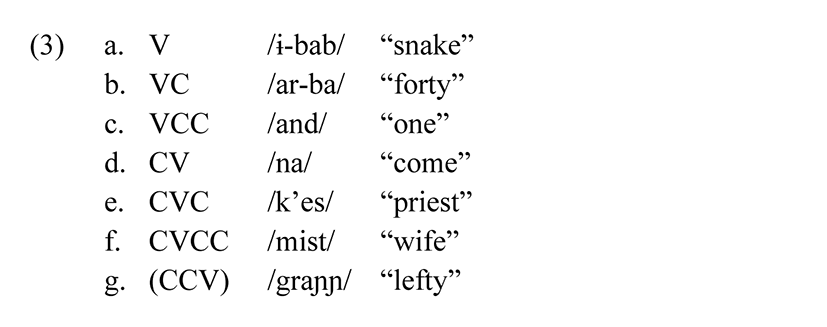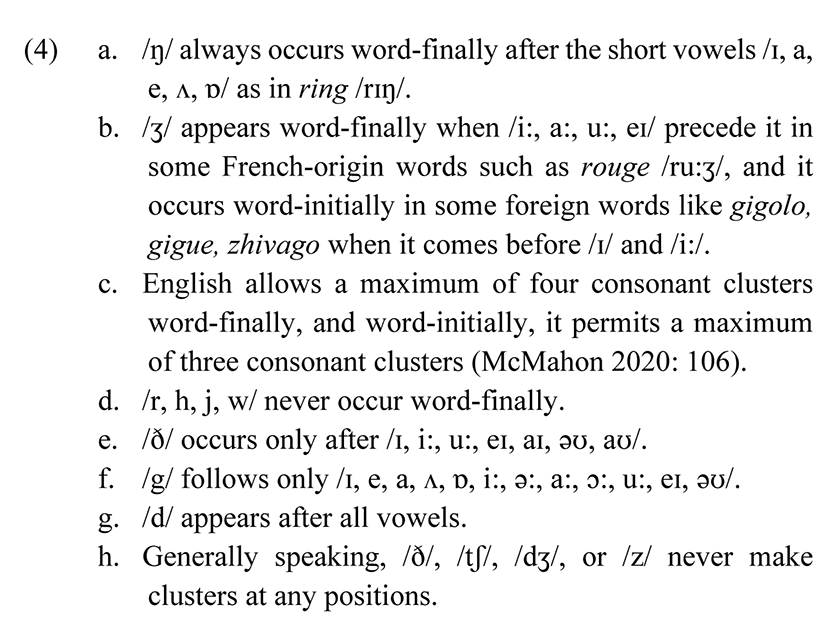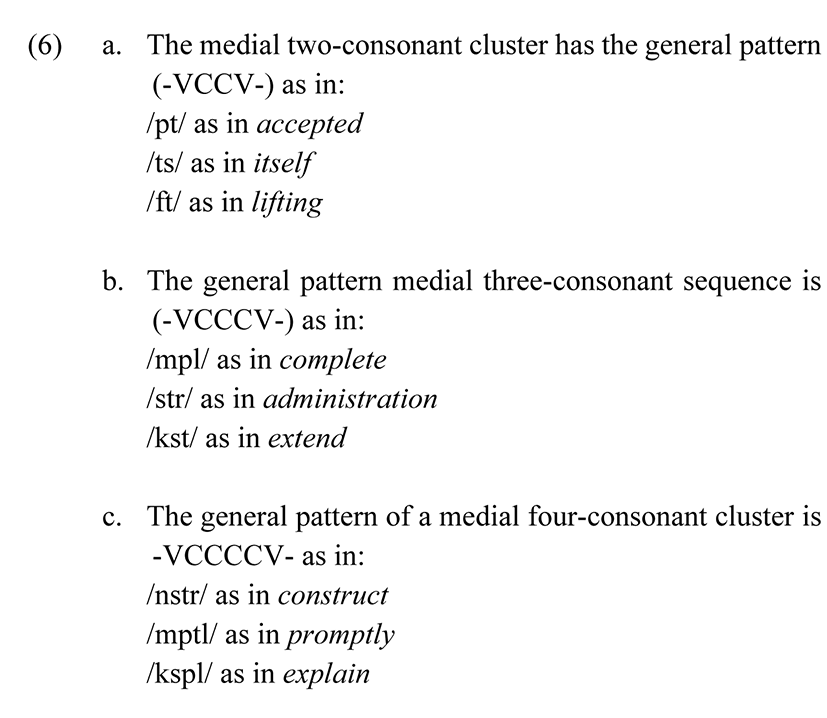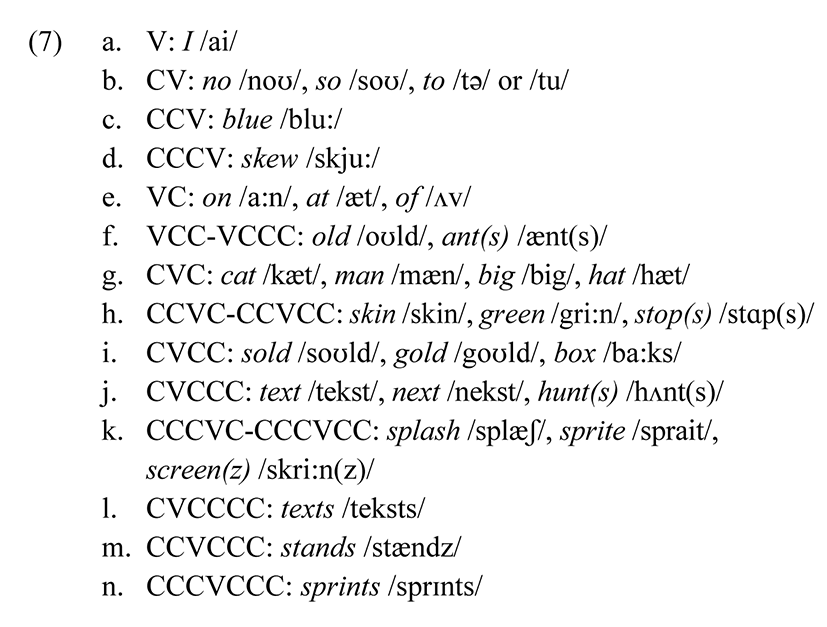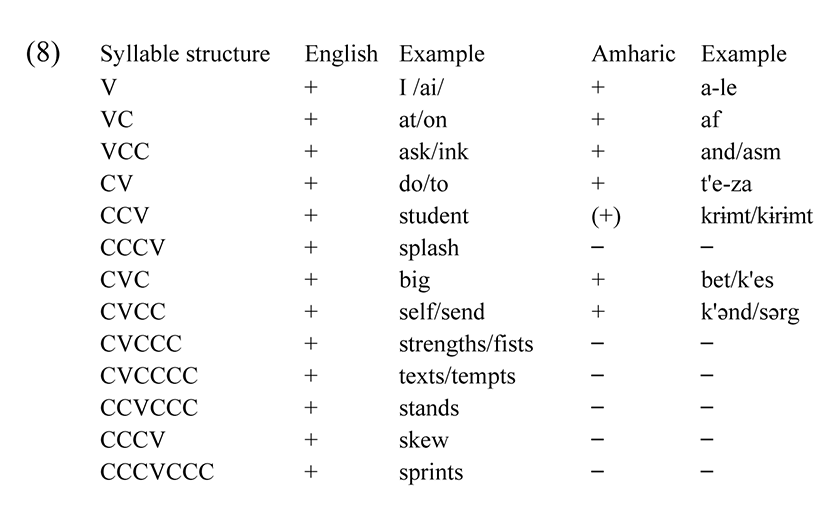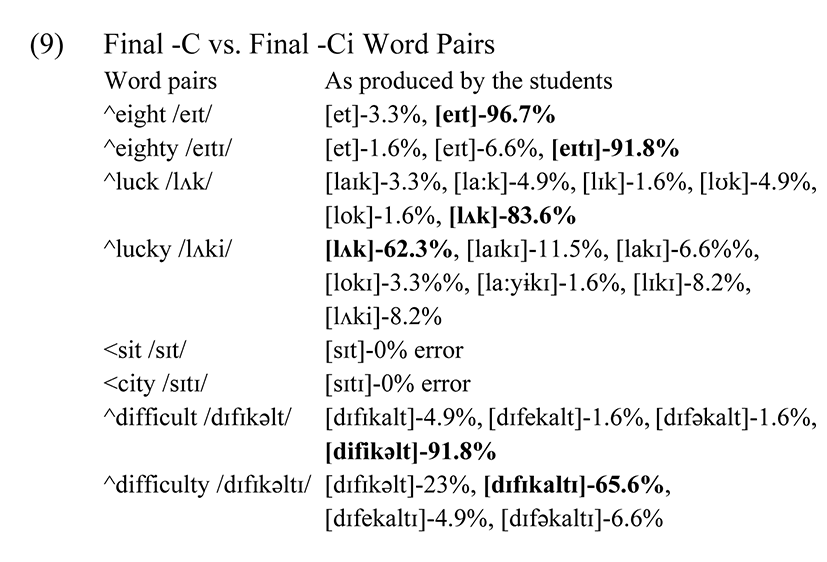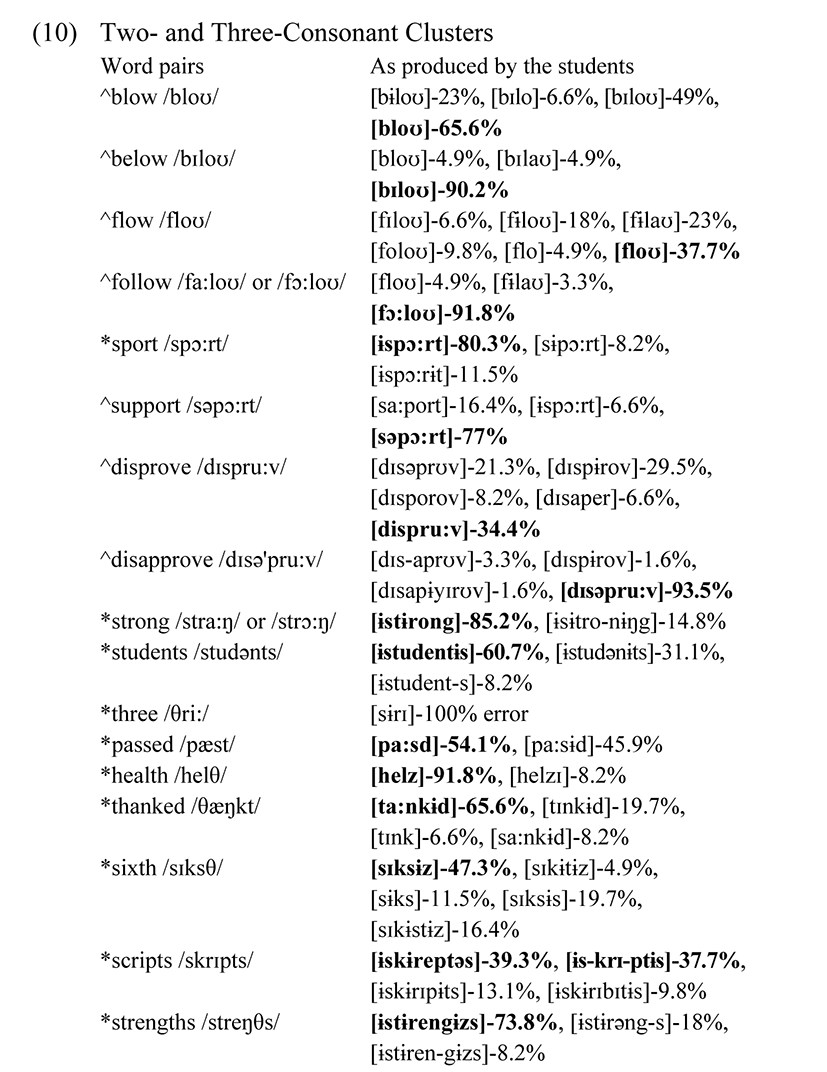1. Introduction
In suprasegmental phonology, the analysis of the syllable’s underlying structure has long been crucial. Phononotactics deals with the language-specific constraints that determine whether sound sequences in phonological words are possible and impossible (Harley 2004: 57). Phononotactic analysis is a well-established technique for studying syllable structure. Generally speaking, phonological patterns of segments that fall inside the bounds of a phonological word are referred to as phononotactics (Hickey 2014: 177). Therefore, phonotactics is concerned with the rules by which a particular language permits the combining of sounds and the sequencing of segments to produce bigger units such as morphemes, syllables, and words.
The phonological nature of the segmentals has an important effect. Compared to a consonant and a neighboring vowel, two adjacent consonants exhibit more phonotactic constraints. Phonotactic limitations exclude different sequences of clusters depending on what is possible and what is not (Zsiga 2013: 223). Learning a new language will undoubtedly present a variety of challenges related to vocabulary, structure, sound system, and other aspects. This makes sense because foreign language learners have long relied on their native language, which has become deeply ingrained as a habitual pattern. Frequently, students carry over their habits into the new language they are learning, which could lead them to mistakes. Evidence suggests that phonotactic sequences that are absent from a native language can be challenging for second or foreign-language learners to produce and understand (Wagner et al. 2012: 30). The English syllables possess two or three consonant clusters in the onset position like /sp-/, /st-/, /sk-/, etc. as in the words sport, star and skill and /spr-/, /spl-/, /str-/, /skl-/, and /skr/ as in the words spring/sprite, split, street/strong, sclerosis, and screech/screen, respectively. However, just one consonant can occupy the onset position in a language like Amharic, which does not permit any consonant clusters in syllables or word-initially. In this scenario, native Amharic speakers may perceive and/or produce English consonant clusters inaccurately since they apply their L1 (Amharic) phonotactic knowledge.
Although comparative studies have been conducted between English and several of the world’s major languages, only a few studies have been conducted between English and Ethiopian languages. Except for Italo’s (1988) contrastive study on the segmental phonemes of Oromo and English, nothing has been done between English and other Ethiopian languages. Italo (1988) addresses the prediction of errors made by native Oromo speakers of English at the segmental level and categorizes the errors based on their types. Some studies have been conducted on Amharic and other Ethiopian languages. Lulseged (1981), for instance, compared the phonologies of Gedeo and Amharic, which are the Cushitic and Semitic languages of Ethiopia, respectively.
As far as Amharic is concerned, Tadesse (1966) conducted a comparative study on Amharic and English segmental properties only. Nonetheless, a contrastive study involving both segmentals and suprasegmentals has not yet been conducted between Amharic and English in general, and the implication of phonotactic constraints between Amharic and English for the teaching and learning of English as a foreign language in particular. Therefore, using the basic assumption of error and/or contrastive analyses, this paper aims to analyze the phonotactic distinctions between Amharic and English and their implications for English language teaching and learning in the context of Ethiopia. The focus of this paper is to comparatively analyze the constituents that impede students from learning English due to the phonotactic differences between their native language, Amharic.
2. Literature Review
Students studying a foreign language have a variety of learning challenges related to its vocabulary, structure, sound systems, and other aspects. To reduce these difficulties, linguists attempt to identify the root causes of the main challenges. To identify potential learning difficulties in second or foreign language acquisition, language experts suggest contrastive analysis, error analysis, and interlanguage theories. In what follows, we discuss contrastive and error analysis theories.
Lado’s (1957) work Linguistics across Cultures lays the theoretical foundations for the CAH1. Lado (1957: 2) states, “Those elements that are similar to the learner’s native language will be simple for him, and those areas that are different will be difficult.” Based on the Contrastive Analysis Hypothesis, areas of interference and/or learning difficulties arise, particularly where the two languages diverge. Similarly, Gluth (2003: 1) defined CA as “the methodical examination of pairs of languages to determine the structural distinctions and similarities between them.” This would imply that CAH asserts that the L1’s “interference” is mostly responsible for the majority of mistakes committed when learning the L2.
According to Lado (1957), ESL or EFL learners tend to transfer their native elements of language and cultural forms and meanings to the target language and culture. This transfer can happen both receptively and constructively when attempting to actively speak the language and behave appropriately in the culture, as well as comprehend and absorb the language and culture as performed by native speakers, respectively.
As the 1970s began, CA was losing its credibility in some ways. Abbas (1995) claims that the fundamental flaw of CA is that it overemphasizes a single kind of error, “interference.” The other criticism is the lack of sufficient empirical evidence that supports the CA hypothesis. It was discovered that many of the faults or mistakes predicted or identified by CA were not evident in learners’ language. However, according to Fisiak (1981: 7), CA should be conducted despite some flaws because not all CA hypotheses are incorrect. It is advised or proposed that teachers should use CA in conjunction with error analysis to address its inadequacies or weaknesses. It serves a helpful explanatory role because it is implemented by pinpointing the mistakes that the students have practically made in the classroom. That is to say, it can still be used to justify some faults and blunders. “Research shows that contrastive analysis may be most predictive at the level of phonology and least predictive at the syntactic level” (Schackne 2002: 199).
The study of error, both in type and number, especially in applied linguistics, is known as EA. EA focuses on actual production errors; It assumes that faults signify learning challenges and that the frequency of a specific error indicates how hard it is for learners to acquire that particular form (Brown 1994). According to the EA approach, CA is insufficient as a technique for pinpointing every area where second language learners struggle (Hammarberg 1972). EA proponents say that to identify the source of interference, we should first list the mistakes of EFL learners, followed by an appeal to conflicts between the learners’ first language and EFL structures (Jain 1975). This indicates that EA proponents are content to employ CA, but only to explain observed errors rather than to forecast errors. However, they deny the notion of error prediction, pointing out that errors that Contrastive Analysis cannot forecast can still be empirically identified using error analysis. In this sense, doing an error analysis study is helpful to pedagogic implications by shedding light on specific language areas to focus on teaching and syllabus writing (Ellis 1997). Nonetheless, EA is also criticized. Some scholars, such as Schackne (2002), claim that EA is insufficient as a foundation for identifying all possible learning issues because it detects only the errors that L2 learners actually make.
We can conclude from the above discussion that CA and EA have advantages and disadvantages of their own. The fundamental distinction between CA and EA is that CA attempts to forecast potential L2 faults, whilst the latter empirically detects errors observed in L2 production. Therefore, in this article, CA and EA are used complementarily since the errors made by the students can be explained by CA and, empirically, can determine the actual errors made by them.
Except for /ɲ/, which does not occur word-initially, all other Amharic phonemes do exist word-initially, medially, and finally (Leslau 1995). Amharic allows only a maximum of two consonants in a cluster at the word-medial or final position; no cluster can have more than two consonants. However, certain clusters of the stop plus liquid type may occur word-initially, but this is not part of the syllable structure of Amharic (see Bender 1974: 21). Nonetheless, the epenthetic vowel /ɨ/ is optionally introduced between the stop consonants and liquids that came before them, as shown below.
According to Bender (1969: 34), while /n, r, s, m, l/ frequently appears as the first element in the final position of a cluster, /b, d, f, g, k, t, t’, s, s’, k’, p’/ hardly appear as the first element of the final cluster in Amharic. In the medial position of a word, every consonant, excluding /h/, can make a cluster with any other consonant. However, when the pronominal suffix /-h/ comes after a consonant, it can appear as the second element in a cluster (Bender 1969: 41). Amharic speakers break up biconsonantal clusters in the initial position by inserting an epenthetic vowel /ɨ/ whose function is to make the English clusters permissible as in their native Amharic language.
Although several researchers, such as Lulseged (1981), Mullen (1986), Alemayehu (1987), Baye (1994), Leslau (1995), and Getahun (1997) suggested different syllable templates and types in Amharic, the following six Amharic syllable structures have been identified.
The following examples illustrate the above six syllable structures in Amharic.
The /ɨ/ in /ɨ-bab/ fills the vowel slot (nucleus) in the Amharic syllable structure without a consonant or a consonant following and preceding it. The /ar/ in /ar-ba/ has the syllable structure VC with no onset. Baye (2016: 27) classified patterns like (1, 4) as open and those like (2, 3, 5, and 6) as closed syllables. He also claims that the CVC is the commonest syllable type in Amharic.
Although Mullen (1986) claims that CVV and CVVC are additional potential syllable types in Amharic, Seyoum (2001: 29) argued that since vowel length is not phonemic in Amharic, CVV and CVVC cannot be syllable types of Amharic.
According to Seyoum (2001: 31), earlier studies on Amharic syllable structure have relied on how different syllable types appear on the surface (phonetic) level. Contrary to this, Seyoum (2001: 43) proposes CV, CVC, and CVCC as the main syllable structures in Amharic after highlighting the phonological manifestation of Amharic syllable structures.
English does not employ all conceivable combinations of phonemes to form syllables and words. Certain phoneme combination rules for English may be inferred from the occurrence of certain syllables and words. Except /ʒ/ and /ŋ/, all English consonant phonemes can occur singly in syllable-initial position (O’Connor 1998). We refer to these restrictions as phonotactic constraints. Regarding the position of some consonant phonemes of English, Gimson (1962/1989: 245–246), Roach (2014: 73), and Crystal (2003: 98) generally note the following information:
The initial position clusters in English can contain no more than three consonants (CCC-). In the case of three-consonant clusters, /s/ must be the first phoneme; the voiceless stops /p/, /t/, or /k/ must be the second element in the cluster, and the set /l, r, w, y/ must be the third sounds. This type of cluster demonstrates the peculiar behavior of (/s/ + consonant) clusters, which defy the rules that other two-consonant clusters follow, such as spew /spj/, stew /stj/, skew /skj/, splash /splæʃ/, and script /skrɪpt/. Uniquely, /s/ can form a three-consonant cluster initially with either /p/, /t/, or /k/, followed by one of the phonemes in the set /l, r, y, w/ as a third element. A list of these kinds of clusters is adapted from Gimson (1962/1989: 245) as follows:
Roach (2014: 68) posits that the two-consonant clusters on the onset in English are of two types. One type consists of the voiceless, alveolar fricative phoneme /s/ followed by /p, t, k, w, j, l, m, n/ as in the words speak, steak, skin, swim, sue, slow, smuggle,and snuggle. He refers to the /s/ phoneme in these clusters of pre-initial consonants, whereas /p, t, k, w, j, l, n, m/ are the initial consonants. The second type starts with /b, d, ց, p, t, k, l, m, n, f, θ, ʃ, h, v, or (z)/ followed by one of the sets of the four approximants /l, r, w, j/ as in, for example, blade, dwell, grant, plate, twins, and quite, etc. Roach refers to the first consonant of these clusters as the initial and the second cluster as the post-initial consonant.
In English, if two consonant clusters occur syllable-initially, one from the set /p, t, k, b, d, g, m, f, v, θ, s, h/ must be the first element with the patterns: /sm/, /sn/, /st/, /sk/, /sp/, /sw/, /sl/, /dw/, /dr/, /θw/, /θr/, /pl/, /pr/, /py/, /tr/, /tw/, /bl/, /br/, /by/, /fl/, /fr/, /fy/, /kl/, /kr/, /ky/, /kw/, /vy/, /hy/, /my/, /gr/, /gl/, /gw/ (cf. Gimson 1962/1989: 244; Kreidler 2003: 115).
Since monosyllabic words do not have any medial consonant(s), a syllable-based approach is inappropriate when analyzing medial consonant clusters. To analyze consonant sequences that cross syllable boundaries, or medial consonant clusters, polysyllabic words are suitable. To examine sequences of consonants spanning word margins, an utterance is also deemed an idea. According to O’Connor (1998: 76–77), four consecutive consonants are the maximum number accepted by median sequences across syllable boundaries, and seven successive consonant clusters can be allowed across word boundaries. Three types of medial sequences exist across syllable boundaries as shown in Kreidler (2003: 128).
The clusters which occur post-vocalically, i.e., after a vowel at the end of a syllable, are called word-final clusters. In English, there are two, three, or four final consonant clusters as presented below.
According to Roach (2014: 71), the final two-consonant cluster falls into two categories: “one being a final consonant preceded by a pre-final consonant and the other a final consonant followed by a post-final consonant.” He also stated that “the prefinal consonant form the set /m, n, ŋ, l, s/” as in “bʌmb ‘bump,’ bent ‘bent,’ baŋk ‘bank,’ belt ‘belt’ and aːsk ‘ask’.” The post-final consonants form the set /s, z, t, d, θ/.
According to O’Connor (1998: 67), the inclusion of endings like the third person singular and plural marking morpheme /-s/, the past tense morpheme (-ed), or those of numerals (-th) causes the clusters of consonants at the end to be more variable.
Generally, this includes /ps/, /pt/, /pθ/, /tθ/, /ts/, /kt/, /ks/, /bd/, /bz/, /dz/, /dθ/, /gd/, /gz/, /ʧt/, /mp/, /md/, /mf/, /mθ/, /mz/, /nt/, /nd/, /nʧ/, /nʤ/, /nθ/, /ns/, /nz/, /ŋk/, /ŋd/, /ŋz/, /ŋθ/, /lp/, /lt/, /lk/, /lb/, /ld/, /lf/, /lʧ/, /lʤ/, /lm/, /ln/, /nt/, /lv/, /lθ/, /ls/, /lz/, /lʃ/, /ft/, /fθ/, /fs/, /vd/, /vz/, /θt/, /θs/, /ðd/, /ðz/, /sp/, /st/, /sk/, /zd/, /ʃt/, /ʤd/. American English has clusters that start with /r/: /rθ/, /rb/, /rd/, /rf/, /rg/, /rk/, /rl/, /rm/, /rn/, /rp/, /rs/, /rt/, /rv/, /rz/ (see also Kreidler 2003: 123).
Typical examples include /pt/ in swept, /ks/ in box, /gz/ in rugs, and /mf/ in nymph.
“The (-VCCC) pattern is quite frequent in English, although it is not found as widely in the language as the (-VCC) pattern” (Todd 1987: 36). In English, there are two sorts of three-final consonant clusters; “the first is prefinal plus post final, and the second type shows that more than one post-final consonants can occur in a final cluster; final plus postfinal 1 plus post-final 2 /s, z, t, d, θ/, is one of the second post-final elements” (Roach 2014: 71–72).
Syllable-finally, three-consonant clusters are common in English. Following is the list of the final three-element cluster patterns as provided by Gimson (1962/1989: 245): /pts/, /pst/, /pθs/, /tst/, /tθs/, /dst/, /kst/, /ksθ/, /mpt/, /mps/, /mfs/, /ntθ/, /nts/, /ndz/, /nʧt/, /nʤd/, /nθs/, /nst/, /nzd/, /ŋkt/, /ŋkθ/, /ŋkt/, /ŋks/, /ŋst/, /lpt/, /lps/, /lts/, /ldz/, /lkt/, /lks/, /lbz/, /lʧt/, /lʤd/, /lmd/, /lmz/, /lnz/, /lfs/, /lfθ/, /lvd/, /lvz/, /lθs/, /lst/, /fts/, /fθs/, /spt/, /sps/, /sts/, /skt/, /sks/. Consider the following examplesː /pst/ in lapsed, /pθs/ in depths, /dst/ in midst, /mpt/ in bumped, and /ŋkt/ in linked.
American English also has word/syllable-final three-consonant clusters rCC as in /rbz/, /rdz/, /rks/, /rns/, /rps/, /rts/, and /rvz/.
Four consonant clusters in the word/syllable-final position are the maximum size allowed in English, but this pattern is rare. It can only be detected when the VCCC form has the inflectional affixes /s/ and /t/ attached to it. According to Roach (2014: 69–73), some good instances are /ntθs/, /mpts/, /ksts/, /mpst/, /lfθs/, /ksθs/, which stand for thousands, exceptions, texts, glimpses, twelfths, and sixths, respectively. These are frequently reduced to triconsonantal clusters by some speakers.
Various phonologists have proposed different maximum syllable sizes for English. For instance, Selkirk (1982) suggests CCVVCC to be the maximum syllable size, where VV is either a long vowel or a diphthong, as in flounce. On the contrary, Blevins (1995) proposed CCVVC as the maximum syllable size, as in dream. I think such proposals will need to find an alternative method or syllable size that can handle terms like strengths /streŋθs/, which exhibits a CCCVCCC syllable pattern.
Generally speaking, there are two main types of syllables: closed and open. A closed syllable is a syllable that contains a consonant in the coda, whereas a syllable that does not contain a consonant in the coda is called an open syllable. Although English has more syllable types, the following are instances of English syllable structures.
Two languages might vary greatly in the combinations they allow. When learning to enunciate SL or FL, this could be a major cause of difficulties. There are two or three initial consonant clusters in English, as in place and split. Despite English admitting three consonant clusters word-initially, the English word rsping is not feasible since /s/ is always the first in clusters of three. In addition, word/syllable-finally, English can allow up to four consecutive consonant clusters as in texts /teksts/.
In Amharic, however, there can never be more than two consonants in a cluster. Besides, Amharic does not permit initial consonant clusters, but if it does, initial consonant clusters are limited to Stop + Liquid types only. When more than three consonant clusters appear in the medial position across a morpheme boundary, the epenthetic vowel /ɨ/ will be inserted to break up the impermissible cluster. For example, while pronouncing words such as sport, spring, split, place, drive, blow, flow, etc., students frequently insert [ɨ] between the English consonant clusters that are not allowed in their native language, Amharic. As a result, learning the complex initial and final consonant clusters in English is challenging for Amharic learners of English. This, in turn, can lead to pronunciation discrepancies between English words, such as blow vs. below, flow vs. follow, sport vs. support, spirit vs. sprite, and drive vs. derive, and thus can hinder communication.
An illustration of the English and Amharic syllable structures is presented in the following table.
Since Amharic does not permit consonant clusters on the onset of a syllable, and more than two consonant clusters word-finally, Amharic learners of English will be challenged by the initial position CC, CCC and, final CCC, CCCC of English syllables.
3. Research Methods
In this article, mixed (quantitative-qualitative) descriptive research methods were used. Data were obtained from 61 University of Gondar third-year English major students. The target group as a whole was examined; no subsample was drawn from this small and controllable number of participants.
Production and discrimination tests were given to the 61 students to collect data, and administered in that order. Both tests were administered to every student. Before the tests were administered, the participants received instructions on how to operate tape recorders, understand the purpose of the tests, and provide genuine answers when asked to do so.
A total of 17 word pair items with consonant clusters and final -C vs. final -Ci were provided for the discrimination test. A native speaker of American English uttered each word and sentence slowly and twice. Students were provided with an answer sheet that had two alternatives for each of the spoken forms. The participants were instructed to listen carefully and underline the words they perceived.
Students were required to pronounce written English sentences during the production test. The test aimed at testing word pairs in context, meaning that each pair was embedded in a complete sentence. The students were able to produce words, phrases, and sentences in a manner that was relatively natural to them. The test was designed to ascertain whether the target groups could generate the items about which they had previously discriminated (or failed to discriminate). The sentences in each section were numbered to avoid confusion. Before reading the phrases and/or sentences, each participant was required to tape-record his/her department, sex, code number, and age.
Following the administration of the two tests, the responses to the first test were analyzed, the data were phonemically transcribed using IPA, and each participant’s recorded words, phrases, and sentences from the production test were examined. The responses to the discrimination test were meticulously graded and examined to determine the challenges faced by the participants.
To determine the challenges the participants faced in producing these word pairs, the results of the production test results were transcribed and then finally compared with identical expressions used for the perception test. The items were presented in context, and there were a total of twenty-four sentences. Three Ethiopian linguistics course instructors who are very good at English, a native American English speaker, and I listened to the recordings and awarded each participant a point for each successfully and correctly uttered item. Subsequently, the participants’ pronunciation errors were categorized based on their kinds.
To analyze the phonotactic constraints between Amharic and English, this article uses an eclectic approach to consonant cluster analysis as stipulated by Kreidler (2003), Roach (2014), and Gimson (1962/1989). Besides, contrastive and error analysis theories were employed.
4. Results and Discussion
61 Amharic learners of English were given discrimination and production tests. In what follows, the results of the discrimination and production tests are presented and discussed accordingly.
The task of the participants was to distinguish between word pairs and words in consonant clusters. There were two parts to the test, containing 17 items: consonant clusters and words with both closed and open syllables.
The items in each pair of the test that the participants were unable to correctly discriminate were enumerated, and the number of responders who had trouble differentiating between each pair was also tallied and recorded. If only one or two of the students were perplexed by a pair, it was regarded as insignificant and disregarded. (# refers to the number of respondents; % represents the proportion of the respondents out of the 61 participants of the study, and the dash (–) indicates that students don’t have significance problem in perceiving the given words.)
Table 1 presents the results of the respondents after hearing ten of the word pairs. The last vowel -i is unstressed in every instance.
Except for “eight,” which was sometimes perceived as “eighty,” most final -C words were correctly perceived. Although they were minor, the problems were with words that ended with -Ci. As Table 1 depicts, in perceiving words like lucky, funny, honesty, city, and difficulty, almost no significant number of students committed any errors. The percentages were greater for the remaining five words. 5%–10% of the respondents misheard the words eighty, party, and sixty as eight, part, and six, respectively. This could be because /ɪ/ is devoiced because of the preceding voiceless consonant /t/. However, the mistake rate was 18% in Germany and 32.8% in dirty. There are specific explanations for the high percentages in these final two instances. It is common to see some Ethiopians use German to refer to the country, the language, and the people; Germany may be used very rarely by the participants. According to my observations, the term dirty has been used by many Ethiopians as a portmanteau word to refer to a noun and an adjective (see Amharic k'oʃaʃa). For native Amharic speakers and most Ethiopians, Germany and dirty are foreign. These students misheard German and dirt instead of the correct words Germany and dirty.
The possibility of adding an epenthetic schwa across a word boundary between final -C and initial C- in Amharic may be the reason for errors. This could cause some people to perceive English words with the final -Ci incorrectly, believing that the unstressed final -i is just an epenthetic vowel and is hence “not there.”
The majority of the issues related to clusters CC are being mistaken with CVC; only rarely did the reverse occur. This is a strategy for modifying English clusters that are not likely to occur in their native language. With a CCC triple cluster—a type that is not present in Amharic—the word disprove contained the greatest percentage of errors (45.9%). Overall, the mistake percentages are fairly low in other words. In the word pair flood/fluid, both directions were difficult (27.9%, 14.5%). This is most likely because university students are more familiar with the word fluid (e.g., correction fluid), which is pronounced as [flud], which is halfway between the canonical English pronunciations of [flᴧd] ‘flood’ and [flu:ɪd] ‘fluid.’ Regarding the word chains, a sizable portion (36.1%) mistook it for Chinese. This looks puzzling because regular Amharic words, like chains, can end in the cluster /nz/ in words such as /wənz/ ‘river.’ The perception error may emanate from the un-Amharic /eɪ/ diphthong or non-existent diphthong found in the English word chain (Table 2).
The production test was the second test used for this article. The majority of the word pairs utilized in the discriminating test were embedded in sentences that the students were recorded reading. Three Ph.D. candidates of linguistics with very good English proficiency, one native American English speaker, and I listened to the recordings of each participant and awarded each one of them a point for each item that the students answered correctly. The following three symbols were used as a rough estimate of the sentence-embedded target words’ phonetic transcriptions as produced by the students.
^ Somebody (but not everybody) pronounced it right
* Nobody pronounced it right
< Everybody pronounced it correctly
The answer with the highest percentage is bolded; unless there were no accurate answers, the last response in each list is the correct (or nearly correct) response. A pause is indicated in the transcription between two sounds when they are separated by a hyphen.
This study only considers the target phonotactic concerns, despite the fact that there were several problems in producing words and sentences, sounds, words, and putting correct stress patterns, and intonation contours.
The results of the production of word pairs with final -C vs final -Ci are presented in Table 3 below.
Table 3 depicts that the majority of participants had no trouble producing words with the syllables C and Ci. There was a single outlier: 38 participants (62.3%) pronounced lucky as luck by dropping the last /ɪ/. My view is that, for the participants, lucky and luck are lexically treated equally; there is typically no linguistic distinction between the two, and hence treated as luck. This could be explained by the vowel becoming devoiced, which makes it harder to hear.
Although the error percentage is minimal, except for luck, Amharic learners of English found it more difficult to pronounce the final -Ci English words than those with the final -C.
Word-initial, medial and ultimate three-consonant sequences proved to be substantially more challenging for the participants than sequences containing only two consonants. Table 4 demonstrates that none of the participants were able to accurately produce the words weaknesses, sixth, thanks, students, strong, disprove and strengths. For instance, the students pronounced the initial consonant cluster in the word strong /strɑːŋ/ as /ɨstɨrong/ or /ɨstɨron-g/; they pronounced the word’s medial consonant cluster in the word disprove /dispru:v/ as /disɨpruv/, /dis-2pruv/, /dispərov/, or /dis-apruv/. The students uttered or pronounced the final consonant clusters of the word students /stuːdənts/ as /ɨstudentɨs/, /studentɨs/, /ɨstudent-s/, or /studenɨts/.
In dealing with two-consonant clusters, 21 (34.4%) students produced blow disyllabically as below, pronouncing it as /bɨloʊ/, /bɨlaʊ/, /bɨlo/, and /bIloʊ/. 38 (62.3%) of the participants pronounced flow disyllabically, pronouncing it as /foloʊ/, /fɨloʊ/, /fɔ:loʊ/, and /fʊlo/; only 2 (3.3 %) students correctly said /floʊ/.
The word health was the other problematic word that the students found troublesome to correctly pronounce. All the 61 (100%) participants pronounced the word health /helθ/ as /helzɪ/ or /helz/ with the phoneme /z/. Predictably, the “dark” velarized /l/ of American English was replaced by the Amharic clear /l/.
5. The Implications of Phonotactic Constraints to Language Teaching and Learning
Every language has phonotactic restrictions “on which phonemes and sequences of phones are permissible in different syllabic positions” (McQueen 1988: 24). As stated by Ho (2003), making mistakes is a method the learner employs to learn, so errors are indispensable to learners due to the difference in phonotactic constraints between their language and second and/or foreign languages. English language learners are unable to fix their mistakes until they have acquired enough information. These mistakes happen when a student is studying because they haven’t learned enough about English phonotactics. They will be able to fix their errors once they are more knowledgeable regarding the language they are studying; the more errors students fix, the more aware they will be of the language.
This article analyzed the phonotactic constraints between English and Amharic using contrastive and error analysis theories and how these phonotactics affect English language learning and instruction in general. Generally speaking, it has been discovered that Amharic L1 speakers who are EFL learners are incapable of producing English phonotactic restrictions, including syllable-initial and final consonant clusters. The findings of this study should be understood in the sense that learners’ awareness and understanding of English phonotactics would be related to the precision of students’ intelligible English pronunciation; they did not develop automated interlanguage phonotactic representations of them. The non-native English learner misinterpreted the pairs of English words provided during the perception test and transferred their L1 (Amharic) phonotactic constraints when producing English words with two or more consonant clusters in any position by inserting the epenthetic vowel /ɨ/.
The teacher encourages the learners to take risks for making mistakes since research highlights the fact that those risk-takers can learn from their mistakes.
It is not easy to locate an organized approach that benefits students. To allow students to participate in the process of getting performance closer to pronunciation standards, teachers can assign the majority of the responsibility to the students for error correction. This allows the teacher to continue their role of guiding, informing, and explaining. This would be more effective and assist the learner in identifying error patterns (cf. Prodromou 1995). The alternative approach is providing feedback to spoken production after the event, so that the need to rectify every single mistake will be avoided. Correcting a student’s pronunciation error in front of the class serves no purpose whatsoever; it is ineffective and demotivating. Since research shows that students who take risks can learn from their mistakes, the teacher encourages the students to take risks even if they result in mispronunciation and wrong perception.
By the same token, feedback on students’ pronunciation issues resulting from phonotactic discrepancies between two different languages should be provided appropriately. According to Brown (1994: 219), getting cognitive, affective, negative, or positive feedback from other people is one of the most crucial things that can make a learner successful. Finding the ideal balance between positive and negative cognitive feedback is the teacher’s job.
Students should be taught by their teachers the importance of proper pronunciation in learning and using the English language intelligibly in different communication situations. The foundations of the English sound system, phonetics, phonology, IPA symbols, etc., should be taught. Students who comprehend English phonetics and phonology can guide themselves toward pronouncing a sound or word appropriately.
Moreover, pronunciation and English ear training lessons must incorporate phonotactic training. It may be possible to teach EFL learners to recognize and pronounce consonant clusters in English that are impermissible in their mother tongue without the use of epenthetic vowels with adequate and proper practices. Their L1 transfer in auditory and articulatory processing may be significantly limited by these teaching and learning activities.
This article claims that EFL students can be taught to employ certain phonotactic cues that are unique to English with the right training. This means EFL learners can become more proficient and pick up some English-specific phonotactic constraints more quickly and effectively with the right instruction. Thus, it is reasonable to conclude that EFL classes at the University of Gondar and other Ethiopian universities can benefit from the explicit teaching of phonotactic constraints.
6. Conclusions and Recommendations
The major objective of this paper is to analyze the phonotactic constraints between Amharic and English, and how they affect language learning and/or acquisition. Three-consonant clusters at any position and some word/syllable-initially and finally consonant clusters of two were found to be problematic. This is further explained by the variations in the two languages’ syllable patterns and the permissible and/or impermissible phoneme combinations. For the students, the final clusters were a bigger challenge than the initial clusters in certain aspects.
Three subcategories of errors can be distinguished: the assumption of erroneous notions, imperfect rule usage, and overgeneralization difficulty.
It is evident from the data that not every problem predicted by CA is a challenge for the Amharic learners of English as a foreign language. Conversely, contrastive analysis does not predict many errors that do surface. This problem can be handled by error analysis, which is a hypothesis that contradicts contrastive analysis. Based on error analysis theory, we can conclude that false assumptions (ideas that are not true) that students make about how the new language works are often the root cause of students’ errors. Three subcategories of errors can be distinguished: the assumption of erroneous notions, imperfect rule application, and overgeneralization.
To improve students’ overall English language pronunciation or oral skills, the following things should be in place.
-
When teaching consonant clusters, teachers should make their own decisions about which clusters to teach and which to ignore. The frequency of occurrence in speech and the level of difficulty for students will be taken into account to deal with students’ problems. Final consonant clusters ought to deserve due attention. It is somewhat accurate to argue that final consonant clusters are more significant than initial clusters, since mispronouncing final clusters with -s and -t might render it difficult to speak grammatically correct English.
-
Pronunciation instruction needs to be given careful consideration from the very beginning. Pronunciation instruction should not be reserved for university students pursuing advanced language studies. Like grammar and vocabulary instruction, pronunciation should be a fundamental component of the English teaching program from the outset. Thus, specific teaching methods or exercises, such as drills for consonant clusters or strategies for integrating pronunciation into early language instruction, should be implemented. Teachers may use tongue twisters, minimal pair exercises, phonetic drills, sentence stress practice, mimicry and repetition, visual aids, and music and rhymes.
-
Teachers should use contrastive analysis and error analysis in a complementary manner to help students learn English.
-
Teachers ought to be responsible for balancing the right amount of feedback, giving out adequate green lights to promote ongoing dialogue, and red lights to draw attention to critical mistakes.
-
Since the sample is very small and may not represent other Amharic speakers with different levels of English proficiency or learning environments, the findings may not apply to all Amharic-speaking English learners. Thus, future studies with more diverse participants should be conducted.









